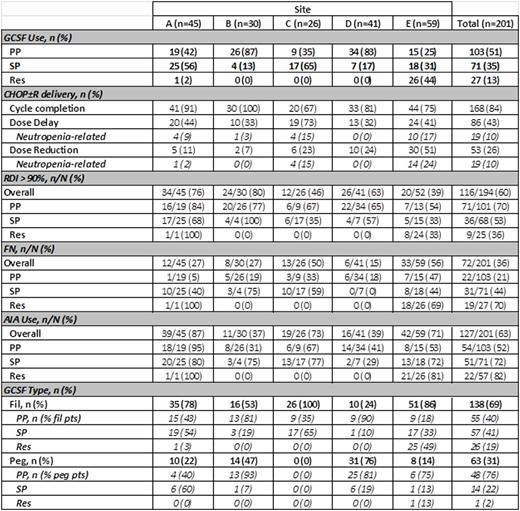Abstract
Background:
First-line aNHL is usually treated with the myelosuppressive CHOP±R regimen. GCSF has been demonstrated to reduce the risk of neutropenia, but published data on GCSF use in Canadian pts with aNHL is lacking. We characterised real-world GCSF use for Canadian pts with aNHL receiving CHOP±R.
Methods:
5 Canadian centres reviewed charts retrospectively for pts with aNHL who received CHOP±R and GCSF between Jan 1, 2010 and June 30, 2014. The proportions of pts receiving primary prophylaxis (PP; GCSF started any day 2-6 of CHOP±R cycle 1), secondary prophylaxis (SP; GCSF started on any day 2-6 of cycles other than cycle 1), or Rescue (Res; GCSF started any day ≥7 in all GCSF supported cycles) were estimated. Dose reductions or delays, relative dose intensity (RDI), febrile neutropenia (FN) rate, anti-infective agent (AIA) use, and type of GCSF were recorded.
201 pts were enrolled. 55% pts were male and median (range) age was 69 (22, 91) yrs with 56% ≥65 yrs. 92% pts had diffuse large B-cell lymphoma and 54% pts had stage IIIA - IVB disease.
PP was used in 103 (51%) pts, SP in 71 (35%) pts, and Res in 27 (13%) pts. More (62%) PP pts were ≥65yrs compared to SP (46%) or Res (56%) pts. 85% PP, 85% SP, and 74% Res pts completed their planned CHOP±R cycles. 43% pts had ≥1 dose delay, more commonly SP (56%) than PP (37%) or Res (30%) pts. Neutropenia-related dose delays occurred for 10% pts, less often with PP (5%) than with SP (13%) or Res (19%). Dose was reduced for 26% pts, more often for Res (56%) than PP (20%) or SP (24%) pts. 10% pts experienced neutropenia-related dose reductions, less often with PP (3%) than SP (11%) or Res (30%). 60% pts achieved RDI >90%, more frequently PP (70%) than SP (53%) or Res (36%) pts.
138 (69%) pts received filgrastim (fil) and 63 (31%) pts received pegfilgrastim (peg) as first GCSF. Fil was used equally as PP (40%) and SP (41%), while peg was used mostly as PP (76%). Peg was administered earlier than fil, with median cycle day-of-initiation on days 2 and 5, respectively. More fil than peg pts were ≥65 yrs (63% v 39%).
36% pts had FN, less commonly PP (21%) than SP (44%) or Res (70%) pts. The FN rate was similar for pts ≥65yrs (35%) and <65yrs (37%); this observation was consistent for PP (21% and 22%), SP (46% and 42%), and Res (69% and 73%) (Figure 1). AIA were used in 63% pts overall and in 52%, 72%, and 82% of PP, SP, and Res pts, respectively.
Differences between sites were common (Table 1).
Conclusions:GCSF was provided most often as PP. Res was used infrequently and predominantly at a single site. CHOP±R delivery was perturbed least frequently for PP pts. Neutropenia-related dose delays and reductions, FN rate, and AIA use were lowest amongst PP pts. FN rates were similar in older and younger pts.
Kouroukis:Amgen: Research Funding; Janssen: Research Funding; Karyopharm: Research Funding. Sehdev:Amgen: Consultancy, Speakers Bureau. Poulin-Costello:Amgen: Employment, Equity Ownership. Gillesby:Amgen: Employment, Equity Ownership. Robson:Amgen: Employment.
Author notes
Asterisk with author names denotes non-ASH members.



This feature is available to Subscribers Only
Sign In or Create an Account Close Modal